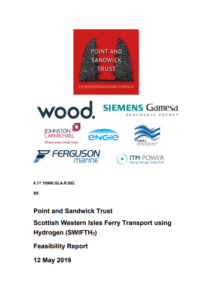Point and Sandwick Trust along with Wood, Siemens-Gamesa, Engie, ITM, CMAL, Johnston Carmichael and Ferguson Marine, published a feasibility study to assess the suitability of using hydrogen produced from local wind farms to power future ferry services operating in the Western Isles and West Coast of Scotland.
The project assessed the practical and economic feasibility of using new island wind farms to produce zero-carbon ‘green’ hydrogen fuel for future types of clean emission ferries operating on the established Caledonian MacBrayne routes.
[smlsubform prepend=”GET THE SAFETY4SEA IN YOUR INBOX!” showname=false emailtxt=”” emailholder=”Enter your email address” showsubmit=true submittxt=”Submit” jsthanks=false thankyou=”Thank you for subscribing to our mailing list”]
Although trials elsewhere have used surplus or ‘free’ electricity to drive small ferries, this does not reflect the full economic cost of switching from marine oil to hydrogen. The Western Isles study is the first to look at the feasibility of using electricity derived from a local wind farm built specifically to power shipping on existing ferry routes.
The study examined the manufacture of the hydrogen using local wind power, the challenges of how to manage, transport and store the hydrogen on local piers, and how the frequency and bunkering requirements of each of the nine routes studied affect the amount of hydrogen fuel required.
In particular the study analyzed:
- The most practical locations and likely output and cost of island wind farms;
- The cost and operation of electrolysers;
- The transport, storage and cost of hydrogen produced from local wind turbines;
- The best location and likely cost of local storage facilities;
- The frequency and bunkering requirements of nine West Coast ferry routes;
- The conversion of the marine oil currently used on these routes into their hydrogen equivalents.
Of the nine routes analysed, the highest-scoring route using a small ferry on a short crossing was from Barra to Eriskay and the highest scoring route using a large ferry on a long crossing was from Stornoway to Ullapool.
The hydrogen necessity for the former would be 219 tonnes and for the latter 3,676 tonnes. A single 4.3 MW wind turbine generator would able to supply the hydrogen needed for the Barra to Eriskay route, while fifteen turbines would be required on the Isle of Lewis.
The likely emissions savings from the replacement of the Barra to Eriskay and Stornoway to Ullapool routes with hydrogen vessels is expected to be about 676 and 21,815 tonnes of carbon dioxide equivalent per annum.
The price of hydrogen that could be sold to ferry operators was estimated to range between £3.70 and £5.60 per kilogram. This would equate to between £0.11 and £0.17 per kilowatt-hour as compared to the current marine diesel fuel of £0.05 per kilowatt-hour.
However, if hydrogen produced from renewable resources for marine transport was to be included in the UK government’s Renewable Transport Fuel Obligation mechanism, it was calculated that the price would reduce between £2.90 and £4.00 per kilogram.
In addition, greening the marine transport sector would contribute to meeting Scotland’s emissions reduction commitments and help its ambition to increase low emission vessels in the publicly owned ferry fleet by 30% and contribute to the 37%fall in transport sector emissions targeted for 2032 Climate Change Plan 2018-2032.
Speaking of behalf of the Point and Sandwick Trust, Project Manager Calum MacDonald stated:
The most exciting finding of the study is that the price gap between using imported oil and local renewables is smaller than many would have expected. To close that gap even more we need further progress in the economics of wind farm and hydrogen production, we need to see the climate consequences of marine oil reflected in its pricing and, of course, we need progress in the design and manufacture of ships to make them more energy-efficient
What is more, Councillor Uisdean Robertson, Chairman of Comhairle Nan Eilean Siar’s Transportation and Infrastructure Committee, added that it is essential for Scotland to look to new and innovative methodologies to decarbonise its transport infrastructure. The possibility of fuelling CalMac ferries using hydrogen offers real potential.
You may read the report in the following PDF































































